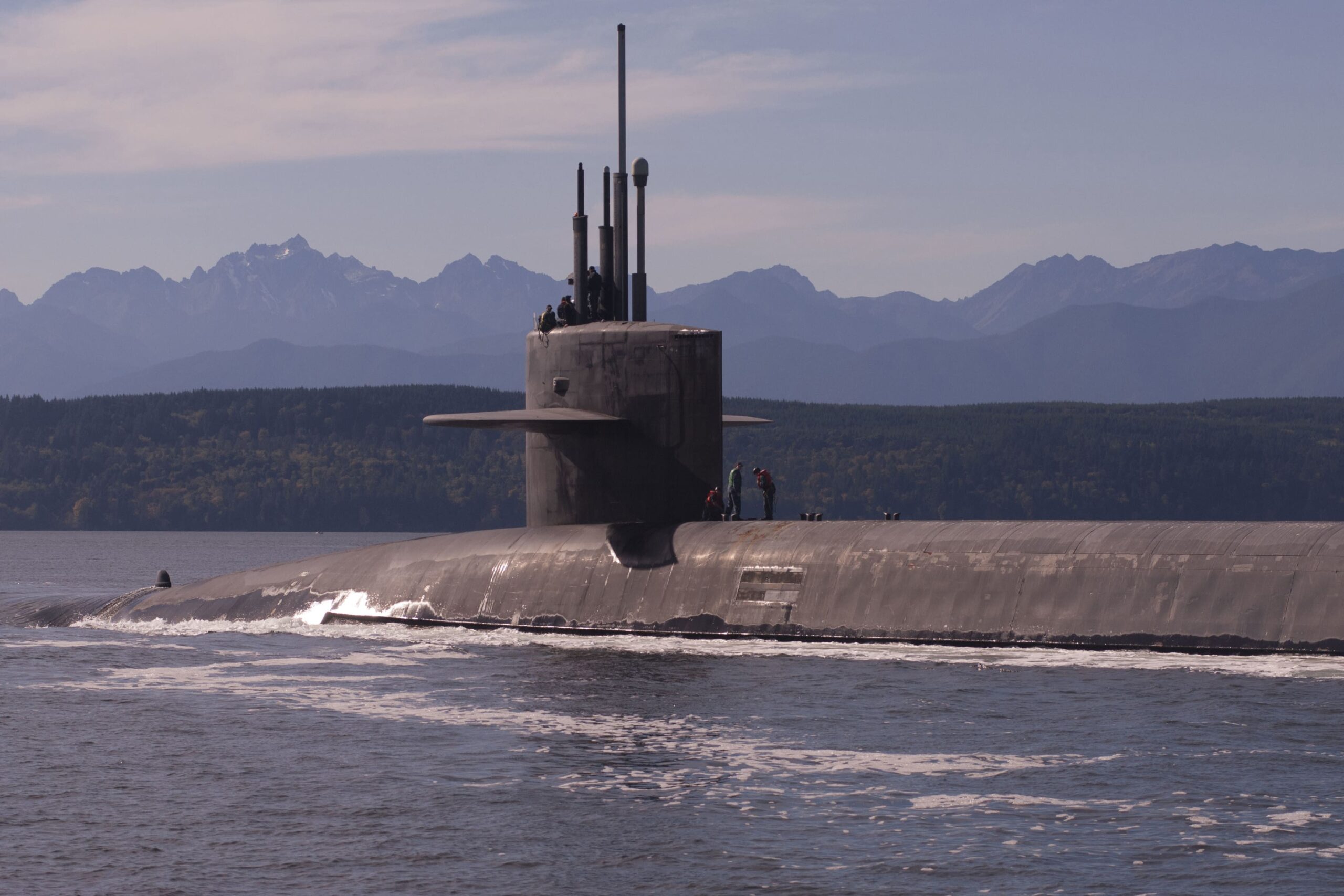The U.S. Navy will run its third Large Scale Exercise (LSE 25) from late July into August. This iteration brings Canadian, Japanese, and NATO representatives into the control architecture for the first time. They will sit beside U.S. commanders to test global decision-making under pressure.
LSE 25 remains a fleet-only drill, yet this year’s scenario includes international participants for the first time. Surface ships, submarines, aircraft, and Marine units stay on normal deployments, yet the scenario forces them to act together as if a single crisis unfolds worldwide. The design stresses every numbered fleet at once, so planners can spot weak links before a real fight starts.
Organizers placed exercise “day one” on 30 July and intend to run continuous play across 22 time zones for almost two weeks. Most action stays inside the Navy Continuous Training Environment, a secure digital twin of the fleet. The virtual setting cuts fuel costs and keeps combat units ready for short-notice tasking.
Global NATO Coordination and Liaison Integration in LSE 25
Rear Adm. Kenneth Blackmon told reporters that about 900 staffers form the exercise control group for LSE 25. They script enemy moves, inject cyber pushes, and watch how real crews adjust. The team also synchronizes role-players who imitate civilian leaders and combatant commanders.
Capt. Christopher Narducci, lead planner, listed every U.S. numbered fleet – 2nd, 3rd, 4th, 5th, 6th, 7th, 10th – as active participants. Each will link to its Maritime Operations Center while higher headquarters at Fleet Forces, Pacific Fleet, and Naval Forces Europe-Africa manage theater-level direction. Marine Forces Atlantic and Marine Forces Pacific mirror the Navy structure on the ground.
Canadian, Japanese, and NATO officers will not sail their own ships during LSE 25. Instead, liaison teams embed inside U.S. command nodes and simulate allied orders in real time. Blackmon said the construct keeps classified networks safe while still “forcing the conversation” that would happen in a crisis.
LSE 25 Joint Force Simulation Across Continents
Major organizations scheduled to plug into the scenario include:
- 10 Maritime Operations Centers.
- 5 Carrier Strike Groups.
- 2 Amphibious Ready Groups.
- 17 retired flag officers acting as national-level authorities.
- Liaison cells from the Royal Canadian Navy, Japanese Maritime Self-Defense Force, and NATO Allied Maritime Command.
Live, virtual, and constructive elements interlock. A destroyer steaming in the Mediterranean can “see” a synthetic adversary bomber generated in Norfolk. That same bomber might also appear on a cruiser’s radar in the Pacific, pushing both crews to coordinate fires through a single global commander.
NATO Exercise Testing Real-Time Global Maritime Command
Planners inserted fresh objectives drawn from LSE 21 and LSE 23 lessons. After-action data showed delays in logistics orders and uneven cyber defense. This year, controllers will inject:
- Sudden loss of satellite communications.
- Simulated missile strikes on fuel depots ashore.
- Accelerated reserve mobilization timelines.
- Demands for humanitarian shipping corridors amid combat.
Officials argue these stressors force commanders to test the Global Maritime Response Plan, a still-evolving method to surge warships faster than traditional deployment cycles.
Industry specialists embedded with the Naval Warfare Development Center will watch how ships route data through commercial satellites when DoD channels jam. According to one senior network architect, early trials showed “latency spikes” when multiple fleets share imagery at once. The team aims to refine bandwidth management tools before full-scale rollout.
LSE 25 Cyber Defense and Comms Resilience Under Pressure
Brig. Gen. Thomas Armas noted that amphibious ready groups will practice passing control from one fleet to another while crossing oceans. The drill measures how fast a commander in Virginia can retask an ARG steaming in the Indian Ocean without losing tempo.
Another layer checks contested sustainment. Sealift planners must route fuel and ammunition along tracks threatened by a notional peer navy. Exercise mentors will score each logistics cell on speed, route diversity, and battle-damage re-assessment.
Cyber teams face their own gauntlet. Red-force hackers will probe unclassified networks that ships use for routine administration. The goal is not to embarrass crews but to verify whether shipboard information-technology teams can contain intrusions and restore services while still fighting their ships. Allied observers will compare these drills with the recently launched joint Cyber Dome initiative by Germany and Israel.
LSE 25 Cost Efficiency and Expanded Allied Interoperability
Congressional staff asked Fleet Forces for a clear cost-avoidance report after critics questioned the price of LSE 23. Budget officers responded that mixing live and virtual play cut operating expenses by 32 percent. Early projections for LSE 25 promise similar savings, even with expanded international input.
From an alliance perspective, the exercise tests more than radios. Canadian and Japanese officers see firsthand how the U.S. combines naval and Marine forces under a single operational picture. NATO observers plan to take notes for North Atlantic contingency planning, especially on fast logistics, drawing parallels to defense-dominated exhibits at the 2025 Paris Air Show, where integrated capabilities and joint operations were a central theme.
Liaison-Driven NATO Participation and Future Hybrid Drill Plans
Defense-Aerospace analysis shows the decision to invite liaison teams – rather than full task groups – keeps coordination manageable while still giving allies deep access to U.S. processes. The method also lets partner nations train without shifting ships away from their regional patrols.
Looking past August, Navy strategists hint at moving the 2027 iteration into a hybrid model with some allied ships operating live. That shift would depend on the success metrics captured this summer and available funding.
For now, LSE 25 stands as the Navy’s most intricate command-and-control rehearsal. Defense officials confirm that every lesson learned will go straight into fleet war-fighting instructions before fiscal-year 2026 begins. That rapid feedback loop, they say, closes gaps while adversaries still guess.
Evaluation points for controllers during LSE 25:
- Speed of cross-fleet targeting approvals.
- Time to restore degraded satellite links.
- Efficiency of contested-logistics rerouting.
- Accuracy of simulated missile-defense engagements.
- Clarity of allied information-sharing across security domains.
Our editorial team will monitor milestones as the scenario unfolds. We will release follow-up coverage when force packages shift, or when planners brief initial findings.
REFERENCE SOURCES
- https://breakingdefense.com/2025/07/navys-biennial-global-exercise-to-include-canadian-japanese-nato-officials/
- https://seapowermagazine.org/navy-marine-corps-in-planning-for-third-large-scale-exercise/
- https://www.janes.com/osint-insights/defence-news/defence/us-navy-broadens-scope-of-its-large-scale-exercise
- https://news.ssbcrack.com/us-navys-large-scale-exercise-2025-to-include-international-participants-for-first-time/



